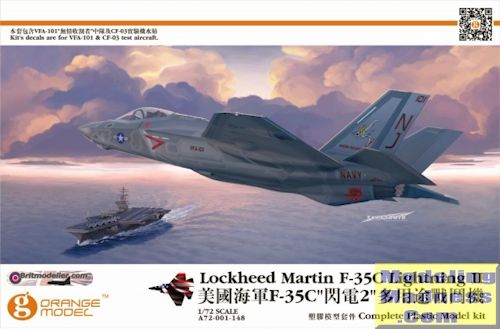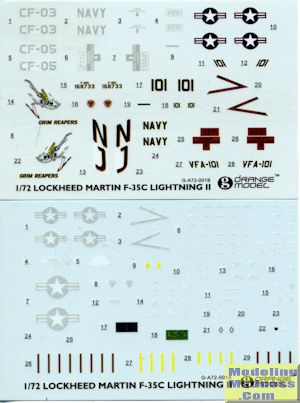
Orange Model 1/72 F-35C Lightning II
| KIT #: | A72-001 |
| PRICE: | $47.00 SRP |
| DECALS: | Three options |
| REVIEWER: | Scott Van Aken |
| NOTES: | New tool kit |

| HISTORY |
Compared to the F-35A, the F-35C carrier variant features larger wings with foldable wingtip sections, larger wing and tail control surfaces for improved low-speed control, stronger landing gear for the stresses of carrier arrested landings, a twin-wheel nose gear, and a stronger tailhook for use with carrier arrestor cables. The larger wing area allows for decreased landing speed while increasing both range and payload.
The United States Navy intends to buy 480 F-35Cs to replace the F/A-18A, B, C, and D Hornets and complement the Super Hornet fleet. On 27 June 2007, the F-35C completed its Air System Critical Design Review (CDR), allowing the production of the first two functional prototypes. The C variant was expected to be available beginning in 2014. The first F-35C was rolled out on 29 July 2009. The United States Marine Corps will also purchase 80 F-35Cs, enough for five squadrons, for use with navy carrier air wings in a joint service agreement signed on 14 March 2011. A recent 2014 document stated that the USMC will also have 4 squadrons of F-35Cs with 10 aircraft per squadron for the Marine Corps' contribution to U.S. Navy carrier air wings.
On 6 November 2010, the first F-35C arrived at Naval Air Station Patuxent River. The replacement engines for at-sea repair are too large to be transported by current underway replenishment systems. In 2011, the F-35Cs were grounded for six days after a software bug was found that could have prevented the control surfaces from being used during flight.] On 27 July 2011, the F-35C test aircraft CF-3 completed its first steam catapult launch during a test flight at Naval Air Engineering Station Lakehurst; the TC-13 Mod 2 test steam catapult, representative of current fleet technology, was used. In addition to catapult launches at varying power levels, a three-week test plan included dual-aircraft jet blast deflector testing and catapult launches using a degraded catapult configuration to measure the effects of steam ingestion on the aircraft.
On 13 August 2011, the F-35 successfully completed jet blast deflector (JBD) testing at Lakehurst. F-35C test aircraft CF-1 along with an F/A-18E tested a combined JBD cooling panel configuration. The tests measured temperature, pressure, sound level, velocity, and other environmental data; the JBD model will enable the operation of all carrier aircraft, including the F-35C. Further carrier suitability testing continued in preparation for initial ship trials in 2013. On 18 November 2011, the U.S. Navy used its new Electromagnetic Aircraft Launch System (EMALS) to launch an F-35C into the air for the first time.
On 22 June 2013, Strike Fighter Squadron VFA-101 received the Navy's first F-35C at Eglin Air Force Base, Florida.
The USN is dealing with the following issues in adapting their carriers to operate the F-35C.
In February 2014, Lockheed said the F-35C was on schedule for sea trials after the tailhook was redesigned. The new tailhook has a different shape to better catch arresting wires. Testing on land achieved 36 successful landings. Sea trials are scheduled for October 2014.
On 3 November 2014, an F-35C of VX-23, one of the Navy's flight test units, made its first landing on an aircraft carrier when it recovered aboard USS Nimitz; this started a 2 week deployment of a pair of aircraft for the initial at sea Development Testing I or DTI, the first of three at sea tests planned for the F-35C. The initial deployment was completed on November 14.
The U.S. Navy may use the F-35C as part of its UCLASS effort to operate a carrier-based unmanned aerial vehicle. Though it has been suggested that the UCLASS could carry air-to-air weapons, an unmanned aircraft lacks situational awareness and is more vulnerable to electronic countermeasures than manned aircraft, and autonomy for deploying lethal weapons is not under development. With the F-35C as the center of a network of naval systems, it could feed information to the UCLASS and order it to fire on a certain target. Large numbers of F-35Cs operating in contested environments can generate a clear picture of the battlespace, and share it with unmanned assets that can be directed to attack.
| THE KIT |
 Molded in a darkish silver-grey plastic, the detail on this kit is quite good. Interestingly, most of the airframe surface detail is raised. This is not the same as the raised line detailing of kits from the 1970s, but since the panel covers are quite wide, these are raised to undoubtedly improve the ability of the modeler to mask and paint these areas. It is a curse of modern 'stealthy' jets that they are covered in two shades of greys, one of them for the panel covers. It will take a lot of work on the part of the modeler to properly do this. Orange Model had produced a set of masks to help in this area and I recommend you get it.
Molded in a darkish silver-grey plastic, the detail on this kit is quite good. Interestingly, most of the airframe surface detail is raised. This is not the same as the raised line detailing of kits from the 1970s, but since the panel covers are quite wide, these are raised to undoubtedly improve the ability of the modeler to mask and paint these areas. It is a curse of modern 'stealthy' jets that they are covered in two shades of greys, one of them for the panel covers. It will take a lot of work on the part of the modeler to properly do this. Orange Model had produced a set of masks to help in this area and I recommend you get it.
There are a considerable number of sprues, so many that a photo wouldn't work well and Orange Model's instructions do not have a sprue layout diagram. Instead, I have included a photo of the completed model so you can see the detailing of which I spoke. Note that most of the light grey areas are raised on the kit. The cockpit consists of a full tub into which one puts a seat, instrument panel and control sticks. There are photo etch frets included that have a seat harness. There are also decals for the instrument panel. All this is covered by a one-piece canopy.
The fuselage is split horizontally. The lower section includes stub wings while the upper contains the full wing out to the wing fold. The kit does have separate wing tips so you can model them folded. The flaps are molded in the upper fuselage section. The lower fuselage accepts inserts for the gear wells, and the weapons bays. There is an etched piece that fits into the exhaust section, which must be installed prior to cementing the fuselage halves together. There is no indication of the need for nose weight.
The landing gear are well detailed and properly robust. The kit is designed to have all the various bays open so there are doors with hinges for the gear and weapons bays. Stabilizers and fins are a single piece and have positive locators. You can install the burner can after the airframe is painted if you wish. The kit has options for either folded or flat wing tips and there are separate pieces for the hinge covers.
 For things under wings you have three wing pylons provided for each side; two for bombs and one for sidewinders. The AMRAAMS fit into the weapons bay. A centerline fuel tank is also provided. For weapons you have two sidewinders and two AMRAAMS.
For things under wings you have three wing pylons provided for each side; two for bombs and one for sidewinders. The AMRAAMS fit into the weapons bay. A centerline fuel tank is also provided. For weapons you have two sidewinders and two AMRAAMS.
A nice addition to the kit is a tow tractor, which uses some of the photo etch. The rest of the p.e. is for tie-down chains and the metal wire included is used for these. Instructions are well drawn with a combination of English and Chinese used. While English is used for the colors, there are other notes that are only in Chinese, but this is not a hindrance to building the kit. Color information is generic. Two decal sheets are included that provide markings for the box art plane from VFA-101 and two of the prototypes. Stencil decals are included and the markings/placement guide is quite large.
| CONCLUSIONS |
Overall, it is a nice looking kit. The detail is well done, the engineering looks to be good and it comes with extras. It is also (so far) the only F-35C kitted in this scale. Painting it will be the biggest issue as without masks, it will be very time consuming. However, this is true of other new 'stealthy' jets, undoubtedly one of the reasons one sees so few built. If this is your kind of subject, then you should seriously consider this one for your shelves.
| REFERENCES |
https://en.wikipedia.org/wiki/Lockheed_Martin_F-35_Lightning_II#F-35C
September 2015 Thanks to www.dragonmodelsusa.com for the preview kit. You can find this kit at your favorite hobby shop or on-line retailer. If you would like your product reviewed fairly and fairly quickly, please contactthe editor or see other details in the